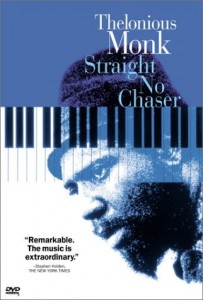Thelonious Monk: Straight No Chaser
From the Chicago Reader (December 15, 1989). — J.R.
The core of Charlotte Zwerin’s exciting if vexing documentary about the great jazz pianist and composer — brought to us through the courtesy of Clint Eastwood as executive producer — is drawn from 14 hours of footage of Monk, in performance and offstage, shot by Michael and Christian Blackwood over six months in 1968. The musical value of this footage is so powerful that nothing can deface it, despite the best efforts of Zwerin to do so: all the worst habits of jazz documentaries in treating the music, from cutting off numbers in midstream to burying them under voice-overs (which also happens on the sound track album), are routinely employed; and, adding insult to injury, the film also takes pains to give us two Monk tunes performed only adequately by a contemporary piano duo (Tommy Flanagan and Barry Harris) in unabridged form. The offstage footage of Monk and the accounts (by friends and family) of the mental illness that accompanied his last years are usually not very illuminating — although here the film at least has the virtue of not presuming to tread beyond the limits of its understanding — and there is virtually no analysis of the importance of Monk’s music on a technical level. Read more

